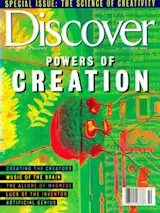Some of Earth’s strangest creatures live around hydrothermal vents--hot springs that bubble from volcanic fissures in the ocean depths. These remarkable animals--tube worms, giant clams, and others--form a food chain that depends ultimately not on photosynthetic plants but on bacteria that live on and inside their bodies. The bacteria break down hydrogen sulfide in the vents, in the process releasing body-building energy for their hosts.
Marine biologists have long wondered how these animals manage to colonize different vents, which may be hundreds of miles apart. Deep currents are too slow to carry vent larvae far before they starve. Some researchers have suggested that whale bones on the sea bottom may act as stepping stones for the larvae by supporting the bacteria on which these communities depend. Larvae landing on the bones would give rise to tube worms and other creatures that eventually spawn their own larvae. Those larvae would in ...














